How To Get Enough Vitamin D (Especially in Winter)
Do you know how to get enough vitamin D? Over 75% of Americans are vitamin D deficient. In this post, I explain how to get enough vitamin D regardless of where you live and the season, as well as how to track your vitamin D level.

Do you know how to get enough vitamin D? Over 75% of Americans are vitamin D deficient. We need adequate vitamin D for healthy bones and teeth and strong immunity. In this post, I explain how to get enough vitamin D regardless of where you live and the season, as well as how to track your vitamin D level.
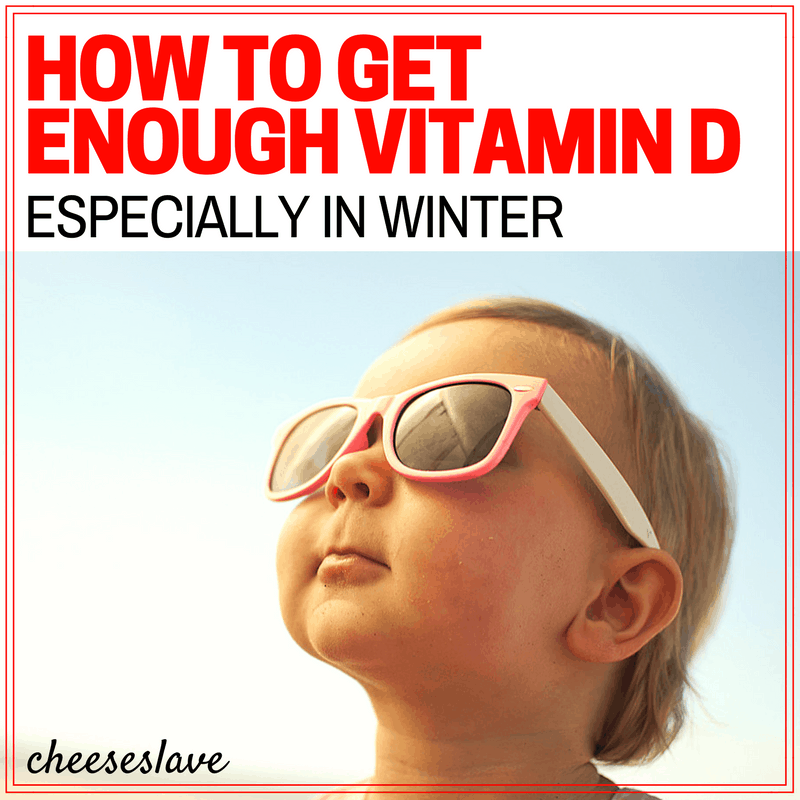
How to Get Enough Vitamin D (Especially in Winter)
It’s not easy to get enough vitamin D from food. The best source of vitamin D is sunshine. Vitamin D from sunshine is free, abundant, and easily made in the body via exposure to the sun.
But what do you do if you just can’t get outside much to get in the sun? And did you know that if you live in a northern latitude, it’s not so easy to get vitamin D from sun? In fact, in most of America, it’s impossible to make vitamin D from the sun in winter.
Are You Getting Enough Vitamin D?
We need vitamin D to prevent osteoporosis and dental decay, and to avoid colds, flu, and even cancer. Unfortunately, over 75% of Americans are vitamin D deficient. So unless you supplement and/or get a lot of sun, most likely, you’re not getting enough vitamin D to keep you healthy.
According to the Vitamin D Council, a healthy range for vitamin D is at 40-80 ng/ml. Some health practitioners say 40-60, others recommend a higher range of 60-80. I personally aim to stay in the range around 50-60. Anything over 150 ng/ml is toxic to human health.
Why We Get Sick in the Winter
Ever wonder why the winter season is “cold and flu season”? Well, it makes sense if you think about it. We get more vitamin D from the sun in spring and summer months. Our body stores vitamin D, but only for a period of time. After our few months of little to no vitamin D from sunshine during the fall and winter, our vitamin D stores become depleted and our immunity weakens.
I know how powerful vitamin D is because whenever I feel a cold or flu coming on (or anyone in my family does), we megadose with vitamin D3 (we usually use the vitamin D3 drops.) For adults, 30,000 IU vitamin D3 every day for up to 5 days, and for children, half that. It works EVERY single time. It will either prevent the onset of cold or flu or totally knock it out. I have even used this to stop Bronchitis in its tracks.
Why It’s Hard to Get Vitamin D from Sun, Especially in Winter Months
As I said above, sunlight is the very best source of vitamin D3. However, you have to work at it. You need to expose quite a bit of your skin at midday sun. It also makes a difference how old you are, how dark your skin is, and your weight. All of these things impact how much vitamin D you can make from the sun.
If you’re north of 37 degrees above the equator, or south of 37 degrees below the equator, you won’t be able to make any vitamin D from the sun at all in winter. In the United States, that’s anyplace north of San Francisco, California on the West Coast or St. Louis, Kentucky on the East Coast.
But it’s worse that that… According to vitamin D researcher, Krispin Sullivan, “In much of the US… six months or more during each year have insufficient UVB sunlight to produce optimal D levels. In far northern or southern locations, latitudes 45 degrees and higher, even summer sun is too weak to provide optimum levels of vitamin D.” (Source)
So if you live in northern states like Washington State, Montana, North Dakota, or Maine, or anywhere in Canada, you’re going to have a tough time getting any vitamin D at all from the sun, even in the summer months.
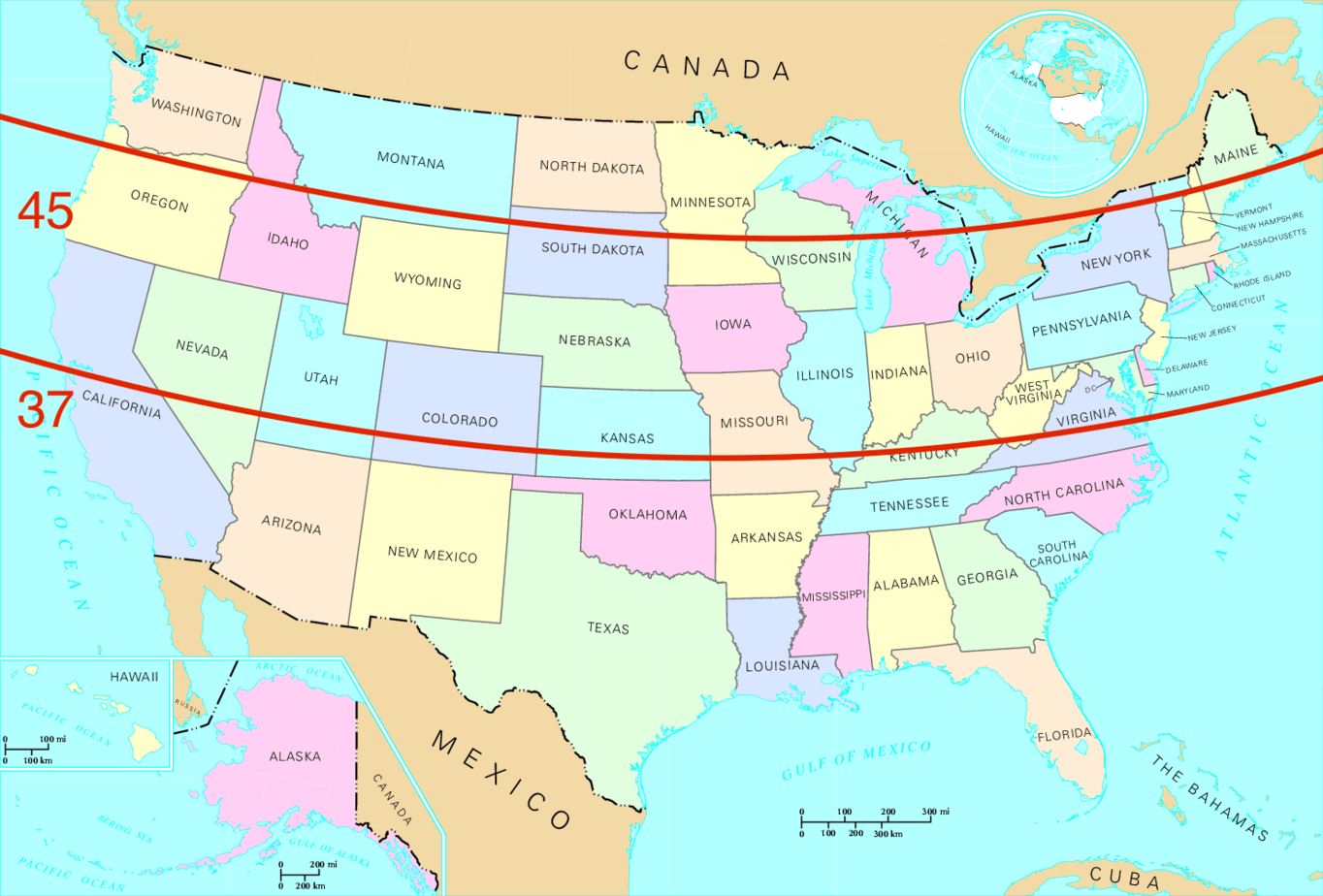
Almost all of Europe is north of 37 degrees, so if you live there, you won’t be able to get sun in the wintertime to produce adequate vitamin D. And unless you’re in Portugal, Spain, Southern France, Italy or Greece, you can’t make adequate vitamin D from the sun even in summer months.
If you live in Northern Europe, you’re definitely going to need to supplement, and/or take frequent trips to sunny locales to get more sun. (Yes, I’m giving you an excuse to take more vacations in Spain and Italy.)
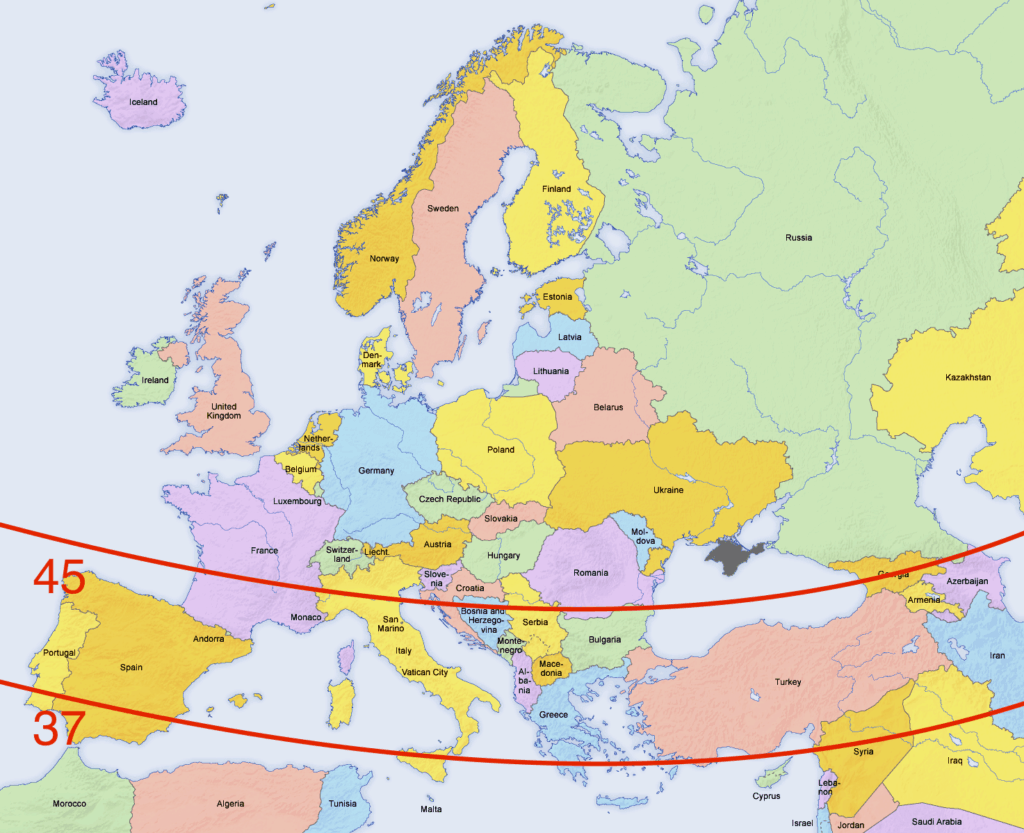
You can find the latitude of your city on this latitude city map.
How Long Does Vitamin D Store in the Body?
We know that vitamin D is stored in the body, but for how long? Vitamin D3 supplements metabolize into 25-hydroxyvitamin D, also called calcidiol. A vitamin D blood test measures the level of 25-hydroxyvitamin D (or calcidiol) in the blood.
The half-life of calcidiol is 15 days. In other words, after 15 days, only half of the vitamin D you consumed from a vitamin D3 supplement remains in the body. After 30 days, only 25% of the vitamin D3 is still in the body.
A 2008 study published in The American Journal of Clinical Nutrition, found that patients given a single dose of 100,000 IU of cholecalciferol (vitamin D3), had elevated levels of calcidiol in their blood for an average of 84 days. This tells us that vitamin D can stay in the blood longer than 84 days, but we don’t know how long.
Why It’s Hard to Get Enough Vitamin D from Food
It’s hard to get enough vitamin D from food, because most foods contain very little vitamin D. In order to get enough vitamin D exclusively from food, you would have to subsist on seafood almost entirely. There’s a reason the Eskimos and other Northern latitude cultures, who don’t get a lot of sunshine, eat so much seafood.
The best food source of vitamin D is fish, by a long shot: cod liver oil and fish oil, and seafood (salmon, oysters, tuna and shrimp). One teaspoon of cod liver oil contains around 250-500 IU of vitamin D3.
One 3.5 ounce (100 gram) serving of salmon contains anywhere from 350-700 IU of vitamin D3. Eel has over 900 IU vitamin D3 in a 3.5 ounce serving. Bring on the unagi!

Egg yolks are a good source of vitamin D, but nowhere near what you get from seafood. You’re looking at anywhere from around 20-60 IU per egg yolk, depending on the source. Eat Wild has reported that eggs from pasture-raised hens raised outdoors have between 3-6 times more vitamin D than chickens raised indoors. However, recent lab tests from the Weston A. Price Foundation do not find that to be true. They actually found higher vitamin D3 in conventional eggs than pastured eggs. They did find higher vitamin A in pastured eggs. Other studies have shown higher levels of vitamin D3 in pastured eggs. It’s not just about sunshine; it really depends on what the chickens eat so it’s hard to know how much vitamin D are in egg yolks.
Dairy products like milk and cheese have some vitamin D, but not a lot, and it’s because D3 (or cholecalciferol, from lanolin, or the wax from sheep’s wool) is added. Vitamin D3 as cholecalciferol is added to most dairy milk. There are some exceptions: the raw milk I buy from Organic Pastures does not have any added D3. An 8-ounce glass of milk with added D3 will give you around 100 IU of vitamin D3.
Most non-dairy milks are fortified with vitamin D2 instead of vitamin D3. Vitamin D2 is not recommended as a supplement, and can be toxic to human health, and may even make people psychotic. If you buy non-dairy milk, I highly recommend you look for a brand that does not contain added vitamin D2. Read more about vitamin D2, the toxic additive in non-dairy milks.
What Is the Best Way to Supplement with Vitamin D3?
If you can’t get enough D3 from the sun and food (including cod liver oil, which I recommend not only for vitamin D, but also for vitamin A and omega 3 fatty acid — read more about the cod liver oil brands I recommend), I recommend taking vitamin D3 supplements.
I am a fan of vitamin D3 drops since they are easy to take and to give to kids. I take D3 drops in addition to cod liver oil during the winter months when I don’t get enough sunshine.
You can order vitamin D3 drops on Amazon.
How Do You Find Out Your Vitamin D Level?
You can ask your doctor for a vitamin D test. Or you can order a vitamin D test online for around $50.
How to Track Your Vitamin D Level With The Free D-Minder App
The easiest way to track your vitamin D level is to download a free smart phone app called DMinder. I love this app!

All you do is download the app, enter your settings (height, weight, skin type, location, etc.), and your current vitamin D level if you know it. (If you don’t have blood test result, you can just guess and over a period of a few months, the DMinder app will get you in range, as long as you’re not wildly off on your guess. If you suspect you’re low, you should get tested.)
The Dminder app keeps track of how much vitamin D you’re getting from sun and from supplements. It also tells you when the sun comes up and the hours each day you can make vitamin D3 from the sun. In Los Angeles where I am, we can only make vitamin D from the sun for a couple hours in the winter months. The Dminder tells you exactly what your optimal hours are to get sun, and what times of the year you can get it where you are.
You will also enter your skin type, because the darker your skin, the longer it takes for you to make vitamin D from the sun.
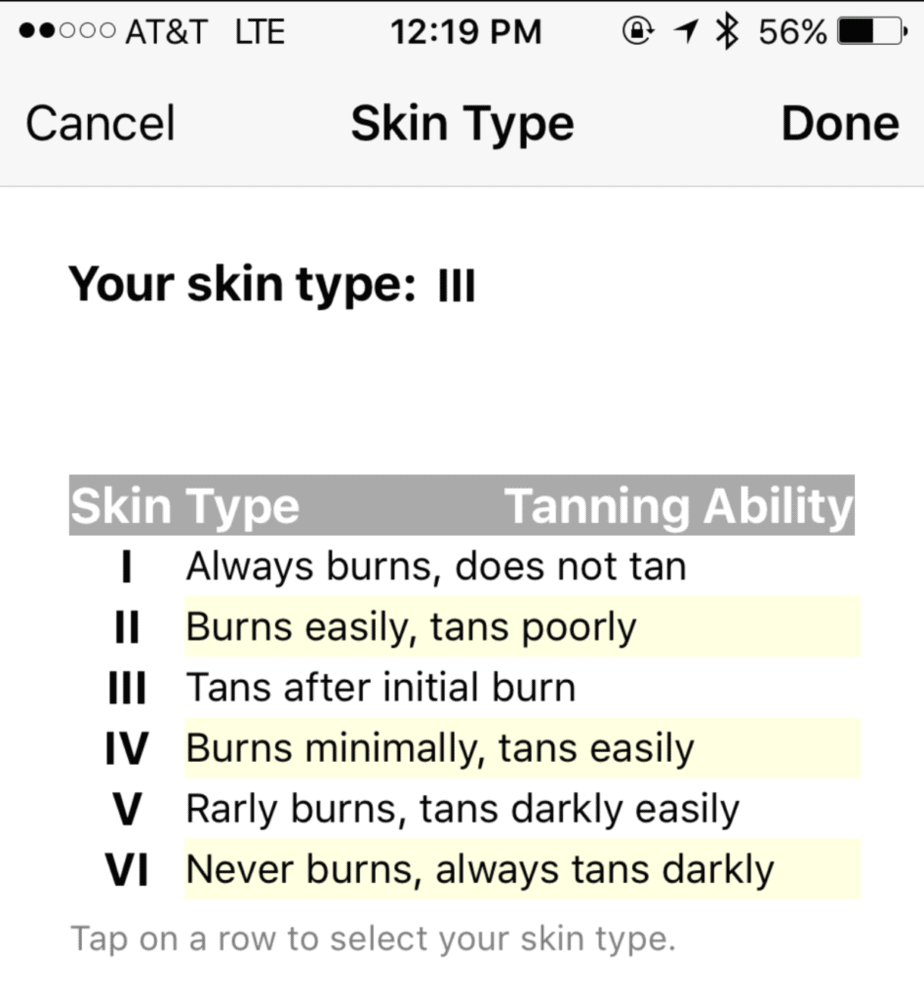
They use something called the Fitzpatrick Scale, which has 6 skin types. This tells you how fast you burn and how long it takes to make vitamin D from the sun.

At first I thought I was a Type 3 because I burn slowly. But I think I burn slowly because I take cod liver oil — the omega-3 fatty acids really help. I never get a sunburn anymore.

But then I realized by googling around that Type 3 is really more of an olive tone, which I am not. This celebrity chart helped me figure it out. My coloring is more like a Type 2 (Gwyneth Paltrow). I’m definitely not a Megan Fox.
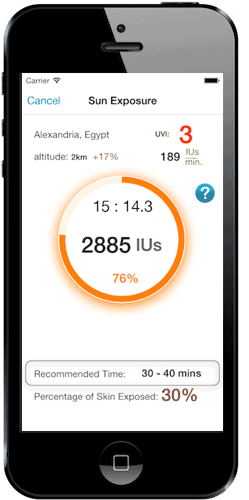
By the way, I highly recommend you eat fish frequently and/or take cod liver oil (I recommend Rosita EVCLO) if you’re planning to get a lot of sun. Not only does it help prevent sunburn but I think it prevents sun damage and aging. I wouldn’t go out in the sun without it!
You also have to enter what you’re wearing whenever you do a “sun session” — you make more vitamin D in a bathing suit than in long sleeves and pants.
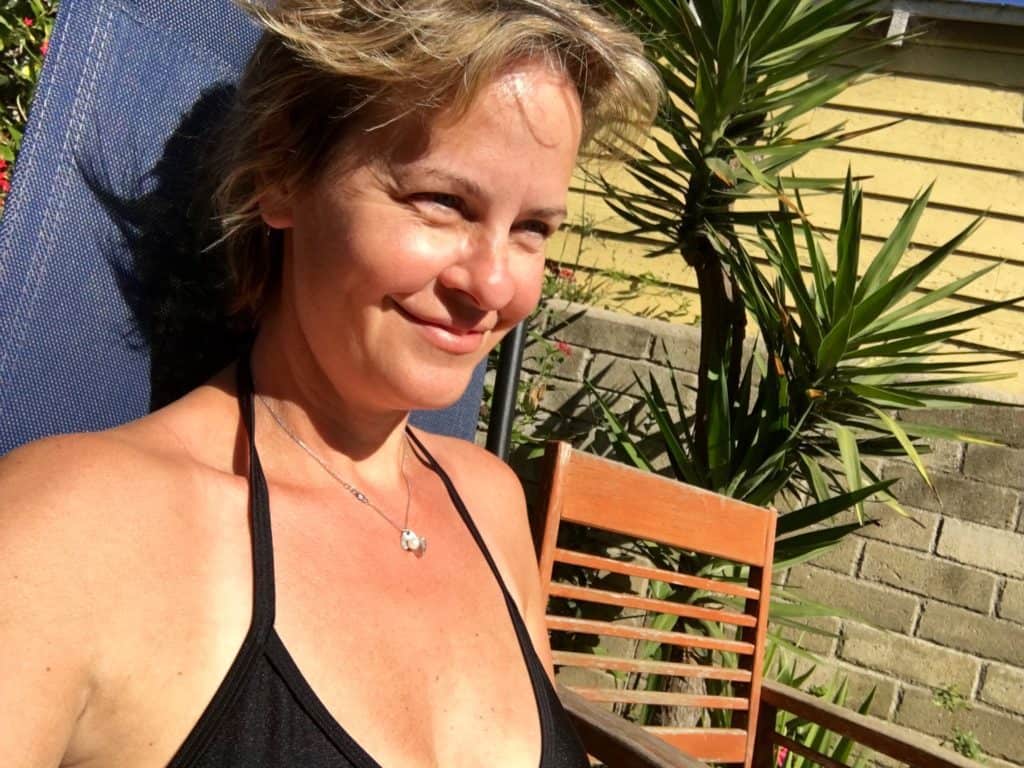
I started using the DMinder app at the end of October last year and have used it consistently. I set it to factor in the 300 IU of vitamin D I get every day from cod liver oil and foods, and then whenever I take D drops, I add it. I also turn it on whenever I go out to get sun (which I’ve been working on — going out in the sunshine at noon for half an hour to an hour in a bathing suit).

I’ve had great results with this app. I have been able to raise my vitamin D level from the 30s to the 50s-60s in just a few months of a little sun plus supplements.
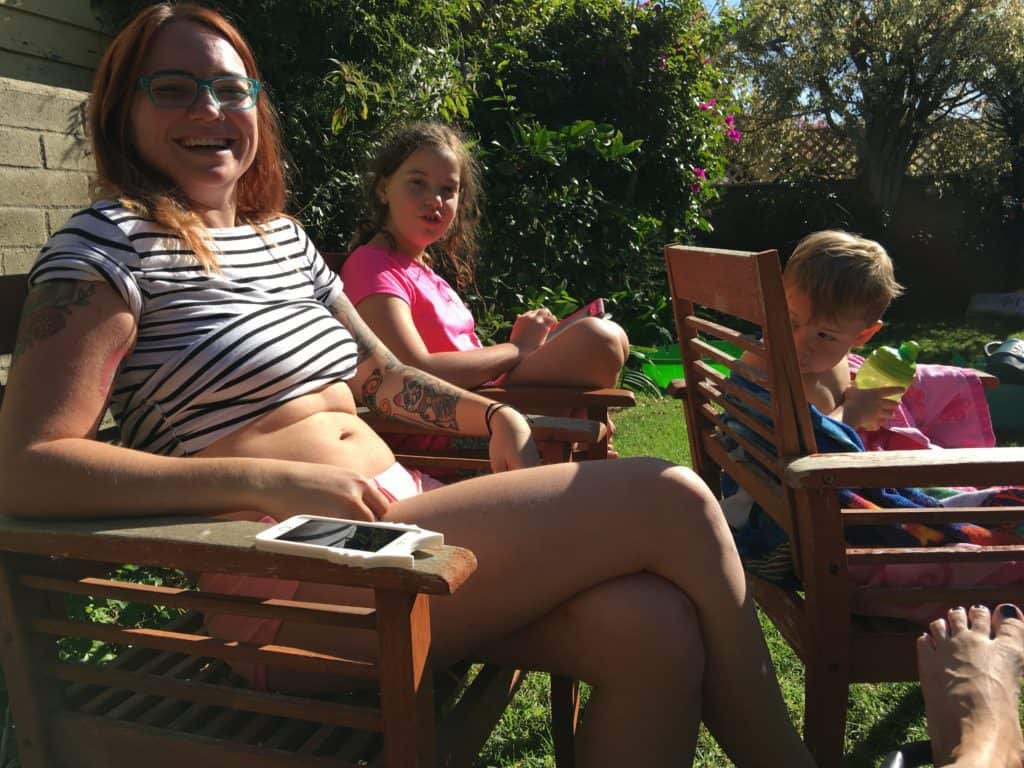
And guess what? Everyone is talking about how they are catching the flu — and I haven’t gotten sick all winter. In fact, no one in our house has gotten sick at all this winter. Thanks to a little extra sunshine, daily cod liver oil (I recommend the Rosita EVCLO, and supplemental D drops.
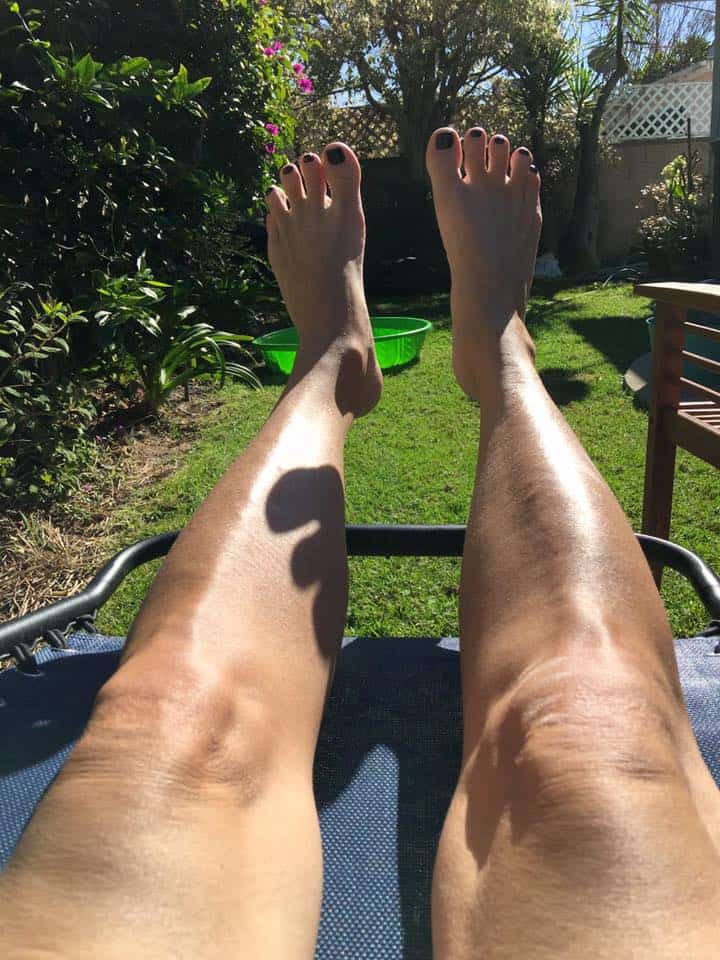
Got Questions? Comment Below
If you have a question or comment, please comment below.
Pin This Post
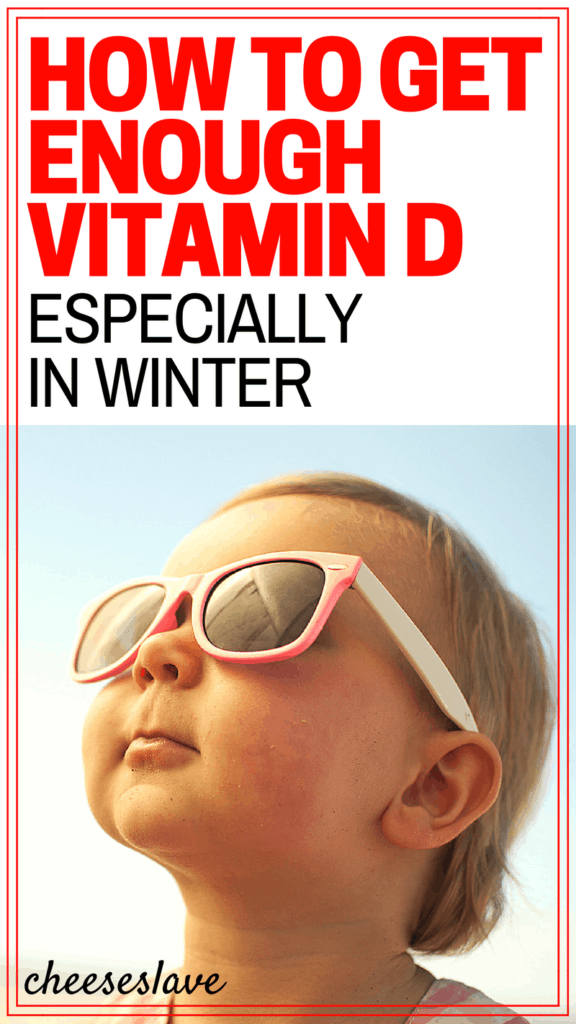
Photo Credit: Mila at the beach


Comments ()